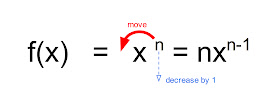First, allow me to present this rule to you in all it's nasty-looking glory:
The only condition that this rule has is that n must be a positive integer. OK, maybe it's not as frightening as I would have made it out to be... but it still doesn't look very friendly. However, when you start doing questions with it, you will understand the easy workflow process and find that it actually is very simple to remember and use!
Let's try a few. Trust me, you will see the pattern and rhythm right away!
Find the derivative of f(x) = x3.
According to our rule, the n value here is 3, so then we have:
f'(x) = 3x3-1 = 3x2.
That's all there is to it!Next, differentiate the function f(x) = x500.
This one seems a bit tougher, but you do the exact same thing. Check it out:
f'(x) = 500x500-1 = 500x499
Easy, right?
Here's a simple image that can help you to remember what you have to do. Like I said, once you start doing these, it is very hard to mess up.
Here's a better way to remember this, which may be even easier to think of but harder to draw: imagine that the exponent is a pile of sequential number cards (e.g. 1, 2, 3, 4, 5...) with the high card on top. When you have to find the derivative, take the top card and place it in front of the x, leaving the card beneath it (which is 1 number smaller) visible. It's easier to actually do this than to draw it, but it's a great way to remember this formula because it is so easy to visualize!
For fun (!), you can see the proof of this by using the Binomial Theorem. I won't go into that much detail here, but in a nutshell, if you start with the definition of a derivative and let f(x) = xn, you can expand the (x + h)n term with the Binomial Theorem. Since the definition requires you to find the limit as h approaches zero, this causes all but the first term of the expansion to equal zero, leaving you with the above result.
So, now you know one of the most common differentiation rules. In my next posts, I'll show you how to apply this rule to your terms when you have a constant value in front of the x. It's as easy as to do as this one! Thanks for reading, and make sure you click the Like and +1 buttons on this page!
Here's a better way to remember this, which may be even easier to think of but harder to draw: imagine that the exponent is a pile of sequential number cards (e.g. 1, 2, 3, 4, 5...) with the high card on top. When you have to find the derivative, take the top card and place it in front of the x, leaving the card beneath it (which is 1 number smaller) visible. It's easier to actually do this than to draw it, but it's a great way to remember this formula because it is so easy to visualize!
For fun (!), you can see the proof of this by using the Binomial Theorem. I won't go into that much detail here, but in a nutshell, if you start with the definition of a derivative and let f(x) = xn, you can expand the (x + h)n term with the Binomial Theorem. Since the definition requires you to find the limit as h approaches zero, this causes all but the first term of the expansion to equal zero, leaving you with the above result.
So, now you know one of the most common differentiation rules. In my next posts, I'll show you how to apply this rule to your terms when you have a constant value in front of the x. It's as easy as to do as this one! Thanks for reading, and make sure you click the Like and +1 buttons on this page!

No comments:
Post a Comment